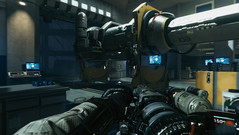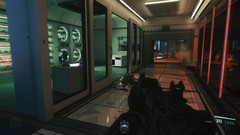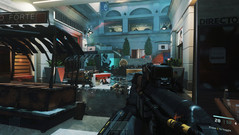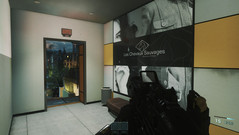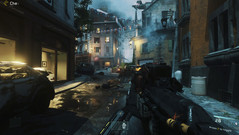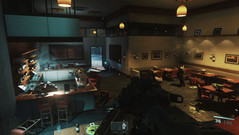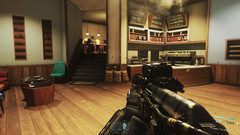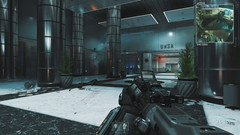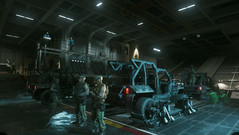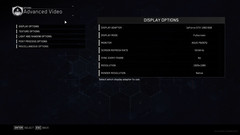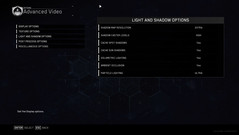Call of Duty: Infinite Warfare Notebook and Desktop Benchmarks
For the original German article, see here.
Graphics
The foundation is the IW engine, which was developed by the series founder Infinity Ward and was originally based on id Tech 3. It was lifted to a next-gen level with Advanced Warfare, but despite several optimizations and extended features over the last couple of years, you can still notice the age of the engine. The textures in particular usually cannot keep up with the razor-sharp Battlefield 1.
The lovely designed figures fall behind the rivals as well, which is also the case for the animations and effects. Most of them look bombastic in Infinite Warfare, but we would rarely call them high-quality. The developers also tend to exaggerate pretty often. When your own player is hit, the vision will blur so much that you can hardly see anything on the screen and often run blindly into disaster.
However, we have to say that there is currently no action title that could challenge Battlefield 1 in the graphics department. This includes Titanfall 2, Mafia 3, Deus Ex Mankind Divided or Far Cry Primal, all of which were launched in 2016. Not even graphics blockbusters like Doom or Rise of the Tomb Raider, which raised the bar quite a bit, can beat Battlefield 1. Compared to a typical first-person shooter, Infinite Warfare does have its graphical highlights and looks decent up to good. We especially like that the developers worked on the loading times. While you still had to wait for multiple minutes before a mission started in the predecessor, even with a Solid State Drive, the missions now start surprisingly quick even on HDDs.
In return, the shaders have to be preloaded when you launch the game for the first time or change the hardware or the system, respectively. The process, which can take up to a couple of minutes in extreme cases, can be stopped, but the game will give you a warning that the performance might be affected. You should have patience during the installation in general. The Steam version, which is used for this article, downloads around 55 GB, and Infinite Warfare will even need around 70 GB on your hard drive (Battlefield 1 "only" used 47 GB at launch).
There are some other negative things we noticed during the tests. We are not talking about the occasional graphics bugs (e. g. with smoke), but primarily the graphics menu, which – first negative aspect – does not include any presets at all. The different tabs make it easier in theory, but the handling is very uncomfortable in practice and time-consuming – even if the game has to be restarted after you changed the texture resolution. Speaking of resolution: Which developer had the idea to apply other resolutions immediately without confirming? If a monitor supports a lot of resolutions, it can feel like hours before you find the right one – including a black screen after every change.
Infinite Warfare can really convince with the number of options. The extended video menu has more than 20 settings, starting with field of view and lighting all the way up to anti-aliasing. Besides FXAA, you will also find 1X and T2X SMAA. All modes will unfortunately result in a certain blurriness, and SMAA works best. Attention tuning fans: Downsampling is supported as well. The implemented grain filter (Filmic Strength & Movie Grain) is certainly a matter of taste. We did not really like it.
One annoying issue was Infinite Warfare's enormous VRAM requirements. If the video memory of the GPU is insufficient, some settings will just be reduced during the game without asking. This was the case for the GeForce GTX 960M 2 GB VRAM and High details. Such paternalism will be a problem for many PC users – independent of the fact whether some settings do not run smoothly anyway.
Infinite Warfare does not run completely smooth in higher settings even with 3 or 4 GB VRAM though. Demanding gamers should at least have 6 GB VRAM, but the first-person shooter will only run completely without little stutters with 8 GB VRAM. Then there is also the integrated FPS lock. While the multiplayer limits at 91 frames per second, you can reach up to 125 FPS in single-player – annoying for users of 144 Hz displays.
Despite the mentioned weaknesses and limitations, the new title leaves a much more sophisticated impression compared to the very "prudish" Black Ops 3 at launch. As for the gameplay, you will get the familiar Call of Duty recipe, which is loved by some gamers because of its simplicity and hated by others because of its casual orientation.
The new version takes place in the future and offers some spectacular battles in space. The word spectacular also – as per usual for Call of Duty – fits for the staging, which consists of adrenaline filled and perfectly scripted fights in diverse levels. Thanks to the good pacing and the nice lighting effects, the whole game is very atmospheric. There are often also generous views with nice panoramic impressions.
The powerful sound and the prominent speakers do the rest to ensure the immersion into the science-fiction world. There is also quite a lot of story for a Call of Duty game. That the initial missions are directly linked to each other without time gaps does enhance the intensity even further, just like the cool cut-scenes.
However, you should not expect a brilliant narrative. In the end and similar to the majority of first-person shooters, Infinite Warfare is a very straight-forward experience where you do not have to think a lot. The bombastic experience can only somewhat compensate for the fact that Call of Duty in its core is outdated…both in terms of technology as well as gameplay.
Benchmark
We use the beginning of the campaign mission "Operation Port Armor: Civilian Terminal" for our benchmarks sequence. The name already suggests that this mission takes place at an airport, which is besieged by enemy troops. We record the first minute with the tool Fraps. The main character jumps out of a spaceship in a buggy and then drives along the airfield while enemies are shooting until the team crashes into a window and has to continue by foot.
This sequence is not only exemplary for the effects in Call of Duty but also the expected performance spectrum. The frame rates are usually much lower on foot and indoors compared to battles and other scenes in space. Because of the heavily fluctuating FPS number, it is tricky to give definitive hardware recommendations. Our sequence represents the average gameplay and not a worst-case scenario (the performance can drop by up to 1/3), so there should still be some headroom for more intense moments. You should be on the safe side as long as the system manages more than 50 FPS in the benchmark.
Results
Even though the graphics quality is a bit disappointing when you consider all the mentioned aspects, the hardware requirements are still similar to Battlefield 1 or even higher. If you want to play Infinite Warfare completely smoothly at 3840x2160 pixels and High details, you will need at least a GeForce GTX 1070. Slightly less powerful high-end chips are sufficient for the standard resolution of gaming notebooks. 1920x1080 pixels and Ultra details are already handled by a GeForce GTX 970M (FHD + High @GTX 965M).
GPUs like the GeForce GTX 960M can at least handle Medium settings in Full HD. Less expensive mid-range chips like the GeForce GTX 950M or 940M are still okay for 1366x768 pixels. Entry-level GPUs like the GeForce 920M are usually not powerful enough for Infinite Warfare. Annoying: The game crashes during launch on Intel GPUs (e. g. HD Graphics 4600). By the way, the processor is usually not a limiting factor thanks to the 125 FPS limit.
| Call of Duty Infinite Warfare | |
| 3840x2160 Ultra / On AA:T2X SM 3840x2160 High / On AA:FX 1920x1080 Ultra / On AA:T2X SM 1920x1080 High / On AA:FX 1920x1080 Normal / Off 1366x768 Normal / Off 1280x720 Low / Off | |
| NVIDIA GeForce GTX 1080 (Desktop), 4790K | |
| NVIDIA GeForce GTX 1070 (Desktop), 4790K | |
| NVIDIA GeForce GTX 1070 Mobile, 6820HK | |
| NVIDIA GeForce GTX 980 Ti, 4790K | |
| AMD Radeon R9 Fury, 4790K | |
| NVIDIA GeForce GTX 980, 6700K | |
| NVIDIA GeForce GTX 1060 (Desktop), 6700K | |
| NVIDIA GeForce GTX 1060 Mobile, 6820HK | |
| NVIDIA GeForce GTX 970, 4790K | |
| AMD Radeon RX 470 (Desktop), 4790K | |
| AMD Radeon R9 290X, 4790K | |
| NVIDIA GeForce GTX 980M, 4700MQ | |
| NVIDIA GeForce GTX 970M, 4700MQ | |
| AMD Radeon R7 370, 4790K | |
| AMD Radeon RX 460 (Desktop), 4790K | |
| NVIDIA GeForce GTX 965M, 6700HQ | |
| NVIDIA GeForce GTX 960M, 4720HQ | |
| NVIDIA GeForce GTX 950M, 6700HQ | |
| NVIDIA GeForce 940M, 5700HQ | |
| NVIDIA GeForce 920M, 2970M | |
| NVIDIA GeForce GT 720M, 4200M | |
| Intel HD Graphics 4600, 4700MQ | |
Overview
Test Systems
| Desktop-PCs | Platform I | Platform II |
|---|---|---|
| Mainboard | Asus Z170-A | Asus Z97-Deluxe |
| Processor | Intel Core i7-6700K (Skylake) | Intel Core i7-4790K (Haswell) |
| GPU | Nvidia GeForce GTX 1060 (6 GB GDDR5) Nvidia GeForce GTX 980 (4 GB GDDR5) |
Nvidia GeForce GTX 1080 (8 GB GDDR5X) Asus GeForce GTX 980 Ti (6 GB GDDR5) XFX Radeon R9 Fury (4 GB HBM) Sapphire Radeon R9 290X (4 GB GDDR5) Sapphire Radeon R9 280X (3 GB GDDR5) MSI Radeon R7 370 (2 GB GDDR5) |
| Memory | 2 x 8 GB DDR4-2133 | 2 x 4 GB DDR3-1600 |
| Storage | Crucial MX100 SSD (256 GB) Crucial M500 SSD (480 GB) OCZ Trion 100 SSD (480 GB) OCZ Trion 150 SSD (960 GB) |
Intel SSD 530 (240 GB) OCZ Trion 100 SSD (480 GB) |
| OS | Windows 10 Pro 64-bit | Windows 10 Home 64-bit |
| Schenker Notebooks | Schenker W504 | Schenker XMG A505 | Schenker S413 |
|---|---|---|---|
| Mainboard | Intel HM87 | Intel HM87 | Intel HM87 |
| Processor | Intel Core i7-4700MQ (Haswell) | Intel Core i7-4720HQ (Haswell) | Intel Core i7-4750HQ (Haswell) |
| GPU | Nvidia GeForce GTX 980M (8 GB GDDR5) GTX 970M (6 GB GDDR5) GTX 880M (8 GB GDDR5) GTX 870M (6 GB GDDR5) GTX 860M Kepler (4 GB GDDR5) |
Nvidia GeForce GTX 960M (2 GB GDDR5) | Intel Iris Pro Graphics 5200 |
| Memory | 2x 4 GB DDR3-1600 | 2x 4 GB DDR3-1600 | 2x 8 GB DDR3-1600 |
| Storage | Samsung SSD 840 EVO (250 GB) | Micron M600 SSD (128 GB) HGST Travelstar 7K1000 HDD (1000 GB) |
Intel SSD |
| OS | Windows 10 Pro 64-bit | Windows 10 Home 64-bit | Windows 10 Home 64-bit |
| MSI Notebooks | MSI GT62VR | MSI GE72 | MSI PE60 | MSI GP62 | MSI CX61 | MSI CX61 |
|---|---|---|---|---|---|---|
| Mainboard | Intel HM170 | Intel HM170 | Intel HM170 | Intel HM86 | Intel HM86 | Intel HM86 |
| Processor | Intel Core i7-6820HK (Skylake) | Intel Core i7-6700HQ (Skylake) | Intel Core i7-6700HQ (Skylake) | Intel Core i7-5700HQ (Broadwell) | Intel Celeron 2970M (Haswell) | Intel Core i5-4200M (Haswell) |
| GPU | Nvidia GeForce GTX 1060 (6 GB GDDR5) | Nvidia GeForce GTX 965M 2016 (2 GB GDDR5) | Nvidia GeForce GTX 950M (2 GB GDDR5) | Nvidia GeForce 940M (2 GB DDR3) | Nvidia GeForce 920M (2 GB DDR3) | Nvidia GeForce GT 720M (2 GB DDR3) |
| Memory | 4x 8 GB DDR4-2133 | 1x 8 GB DDR4-2133 | 2x 4 GB DDR4-2133 | 1x 8 GB DDR3-1600 | 1x 8 GB DDR3-1600 | 1x 8 GB DDR3-1600 |
| Storage | Samsung NVMe MZVPV128 SSD (128 GB) | Toshiba THNSNJ128G8NU SSD (128 GB) WDC WD10JPVX HDD (1.000 GB) OCZ Trion 100 SSD (480 GB) |
Toshiba MQ01ABF050 HDD (500 GB) | WDC Scorpio Blue HDD (1.000 GB) | ||
| OS | Windows 10 Pro 64-bit | Windows 10 Home 64-bit | Windows 10 | Windows 10 | Windows 10 | Windows 7 Home Premium 64-bit |
| Asus Notebooks | Asus G752VS | Asus N551ZU |
|---|---|---|
| Mainboard | Intel CM236 | AMD K15.1 |
| Processor | Intel Core i7-6820HK (Skylake) | AMD FX-7600P (Kaveri) |
| GPU | Nvidia GeForce GTX 1070 (8 GB GDDR5) | AMD Radeon R9 M280X (4 GB GDDR5) |
| Memory | 4x 16 GB DDR4-2400 | 2x 4 GB DDR3-1600 |
| Storage | Toshiba NVMe THNSN5512GPU7 SSD (512 GB) | Samsung SSD 830 (256 GB) |
| OS | Windows 10 Pro 64-bit | Windows 10 64-bit |
| 4K-Monitor | Nvidia driver | AMD driver | Intel driver |
|---|---|---|---|
| 2x Asus PB287Q | ForceWare 375.70 | Crimson 16.11.2 | 15.40.28.4501 |







